Today's workforce is diverse, demanding, and dispersed. Some employees are in the office, some are at home, some are traveling for work, and some do all three at various times. There's an interesting generational mix with baby boomers working with Millennials and Gen Zs.
Companies strive to ensure adequate training and development opportunities, which means adapting to various learning needs. Personalized corporate training has never been more important, especially since everything else in our lives is programmed to cater to individual preferences — from the ads we see to social media feeds and streaming services content. People expect corporate learning to be personalized, and traditional, linear training is no longer the only solution.
Especially in a hybrid work setting, it's increasingly difficult to engage learners. Learning management systems (LMSs) have evolved to cover the growing needs for flexibility and customization.
Why use an intelligent learning platform for personalized corporate training?
All the factors mentioned above have led to the development of intelligent learning platforms (ILPs) designed specifically for the needs of today's corporate environment. An ILP is learner-centric while also considering the challenges and needs of the learning designers and instructors. A well-balanced mix of an LMS and an LXP, the ILP comes with many advantages:
- A lighter workload for instructors. With an ILP, L&D specialists can set up automated recommendations when learners set goals. This greatly reduces the quantity of manual work needed to curate and assign training to each employee. The automation feature ensures a seamless, personalized learning experience from beginning to end.;
- Enriched content. Not only do instructors have to stop worrying about handpicking and delivering the right learning content for each employee, but there's also a wealth of content from third-party providers (such as LinkedIn Learning, Udemy, or Go1) that is part of the available recommendations pool. Greater diversity ensures greater personalization;
- Enhanced learning paths ensure that no one falls behind in achieving their goals. Comprehensive learning paths string together seamlessly various learning resources (online courses, assessments, video content, and more);
- Setting learning goals helps learners reach their career objectives based on particular competencies. Based on what the learner wants to achieve, they can get personalized, proactive assistance in the form of recommendations.
- Progress tracking is essential in employee development. With an ILP, you have an overview of the goals and competencies that the learners are mastering. This helps instructors see how employees are progressing through the training materials and allow them to intervene when there's a need for support;
- Adding competencies to groups is another highly useful feature of an ILP. This will allow learners who have mastery of specific competencies to interact with peers with the same interests and goals;
- ILPs foster a sense of community. Social interaction stimulates learners to be more engaged, even when they are not sharing the same physical space with their peers.
- Cost-effectiveness is also a big plus. Personalized corporate training usually requires a higher investment but having an ILP saves money in the long run as L&D specialists have a lighter workload. Employees perform better on their jobs and are more satisfied with their training experience.
Read more: What is an intelligent learning platform for businesses?
How to create a personalized corporate training program using an intelligent learning platform
An ILP offers all the features you need to make informed decisions while building personalized learning strategies for your corporate training.
-
Setting learning objectives
For corporate learning to be truly personalized, the employee needs to be in charge of setting the learning objectives that are relevant to them. Whether these are related to performing better in the current job or moving up in the hierarchy, an ILP gives the learner the power of choice. For example, someone who is a Junior Learning Specialist can set “becoming Learning Executive” or a “Learning Consultant” as a goal.
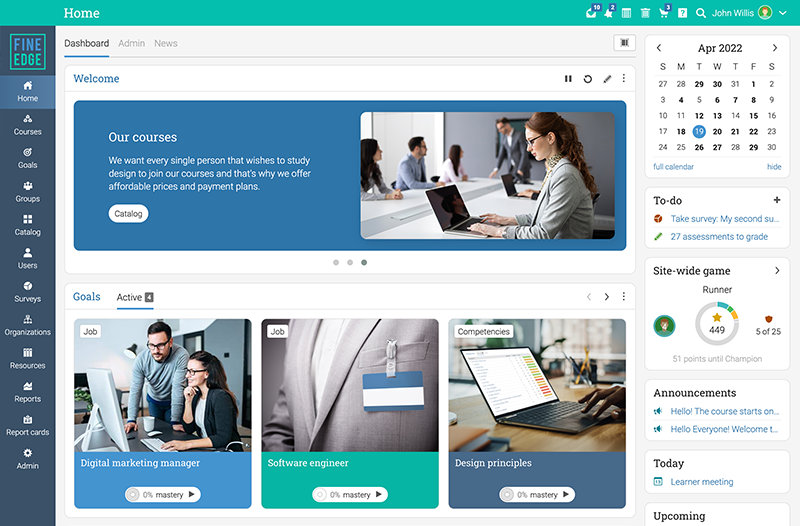 Employees can easily see their learning goals chosen by themselves or their team leaders.
Employees can easily see their learning goals chosen by themselves or their team leaders.Managers can also set objectives for their individual team members or their entire teams. Once the goals are set, the platform will automatically show all the recommendations and competencies related to that particular objective. Furthermore, an ILP can assess what has been already mastered and to what extent to make an accurate skill gap analysis and give personalized recommendations. If you are an L&D specialist, this feature is particularly advantageous. You can easily monitor learner progress via the goal overview page and intervene when employees fall back on mastering their goals. The ILP can also link the individual learner to groups to help them achieve the desired competencies. By linking the competencies that the learner wants to master with the courses, groups, and resources tagged with them, the ILP starts generating recommendations.
-
Setting training competencies
Competency-based learning is an innovative approach to training. The learner moves from a basic level to a higher one based on mastery assessment and progress rather than based on time spent on a particular course. The focus is on acquiring the right knowledge and gaining the right skills.
With an ILP, you can set up competencies for each individual goal or job role. For example, suppose you are designing a course for a Junior Marketing specialist before you even begin creating the learning materials. In that case, you make a list of all the individual competencies that a person needs to master.
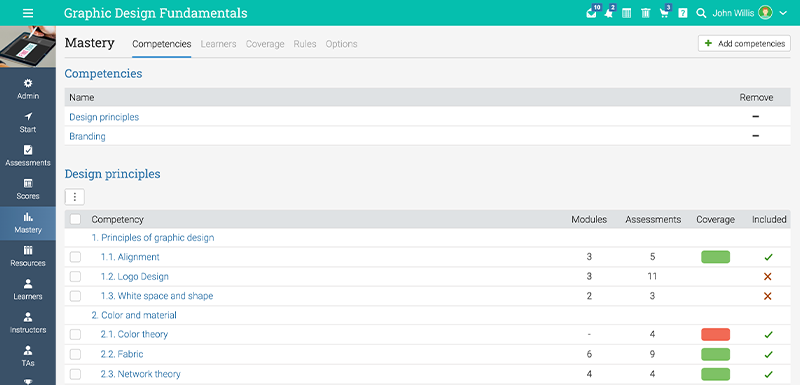
You then divide these competencies into groups to make it easier to work with them. You can even upload them into the resources library of your organization so that everyone can access and use them. With an ILP, you can tag all these individual competencies to the modules you create and various assessments.
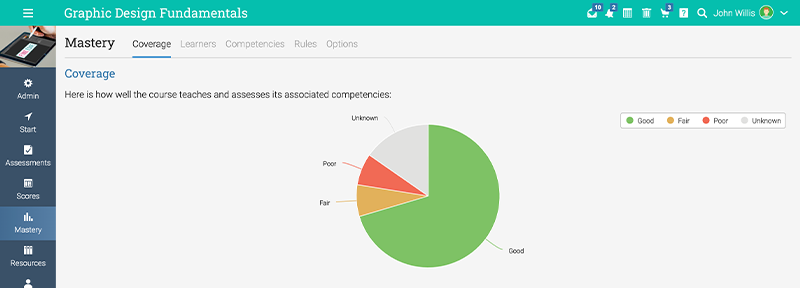
Doing this helps you get a good idea about how well various skills are covered and find out very quickly where there are knowledge gaps.
Read more: Top 5 corporate learning KPIs for measuring training success
-
Extensive course catalog
A successful platform needs to be an open one. Today's learner wants to have all the available knowledge at his fingertips, and with a wealth of quality content, restricting options can lead to low engagement levels.
Furthermore, since not everything on the web is qualitative, you need reliable providers like Udemy, Go1, and LinkedIn Learning.
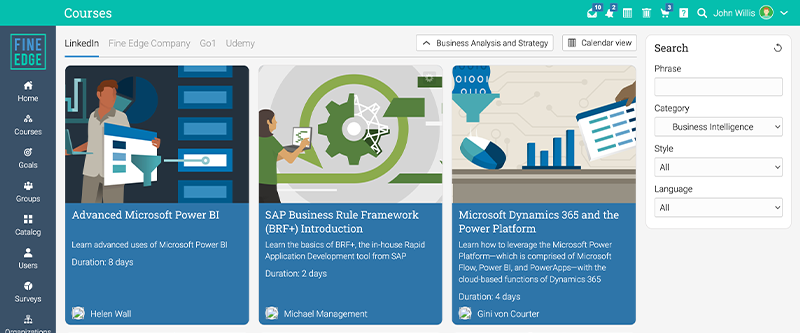 An ILP is great for both in-house training content creation and hosting third-party content.
An ILP is great for both in-house training content creation and hosting third-party content.Doing this will raise the standards in terms of future recommendations and overall learner satisfaction. Having a wide variety of content — courses, videos, podcasts, conference talks, e-books, etc. — is of great help to instructional designers who save a lot of time and effort when building learning paths.
-
Creating learning paths
Traditionally, corporate training uses well-planned learning paths. Whether the delivery method was face-to-face or through an LMS, modules were constructed in the same fashion as you would a book with chapters following one another. The learners had to go through these linearly, and once they got to a certain percentage, they passed and earned their certification. For example, your company just hired a junior Graphic Designer, who enrolls in the "Basics of HR" learning path and either passes or fails at the end.
caption_text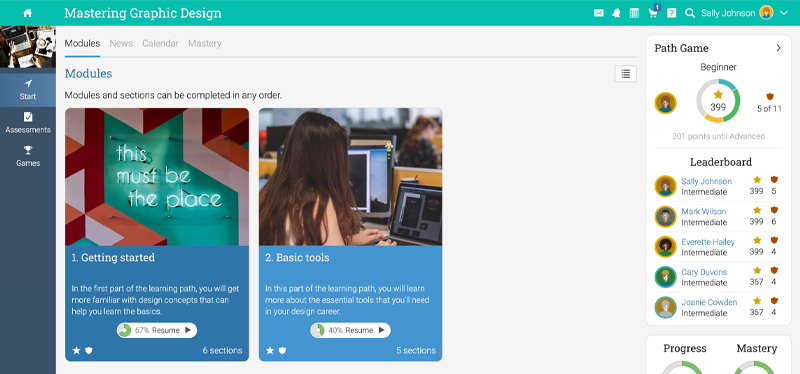 Individual employee learning paths can be dynamic and show a wide range of content: videos, written text, etc.
Individual employee learning paths can be dynamic and show a wide range of content: videos, written text, etc. The problem with this is that both managers and learning specialists cannot get granular information – if an employee struggles with a module, it's challenging to figure out why. Learning paths need to be highly dynamic and consist of more than e-learning modules. A path could very well, for example, start with a video or an infographic and then move on to other types of learning content.
-
Enabling learning recommendations
An ILP allows you to provide adaptive learning to your employees based on their previous experience and performance. For example, if an employee does well on a quiz, there will be an automatic reveal of some advanced materials. On the other hand, if the results on that same quiz are very poor, remedial materials will be revealed. The administrators can configure the recommendations engine to automatically recommend various types of resources based on multiple factors.
 Learners get personalized recommendations based on their goals and performance.
Learners get personalized recommendations based on their goals and performance. Let’s say that the platform detects that an employee is on their way to mastery of a specific objective but is struggling with a particular competency. In that case, it will generate recommendations, and in their turn, these will trigger actions that the learner can take. Whether it's courses, assignments, or mentoring opportunities, ILPs will automatically send the learner content recommendations based on their performance and goals without requiring a prior needs analysis done by the instructor.
-
Learning analytics
The ILP also comes with a comprehensive set of analytics and reporting tools that can help businesses get relevant information about the organization’s training activities. In turn, this data is very valuable for creating personalized learning strategies for corporate training. You can see learner progress, activity timelines, and run assessment analytics to check individual performance.
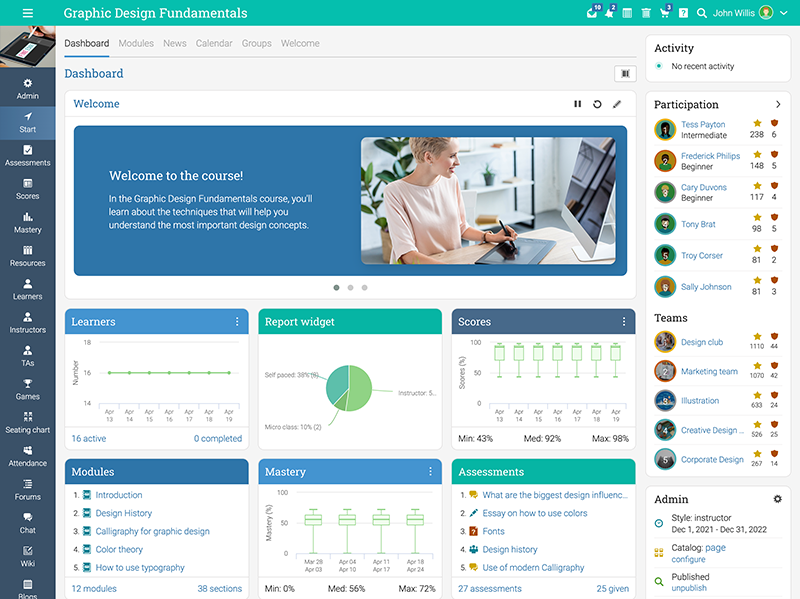 The ILP’s analytics features can evaluate mastery level for the various competencies associated with a learner's goal.
The ILP’s analytics features can evaluate mastery level for the various competencies associated with a learner's goal.The platform offers the possibility to have canned reports — pre-built, automated reports to retrieve data with a recurring set of specifications — or ad-hoc reports for quick insights on an as-needed basis. For this type of quick reporting, you have the option of integrating dashboard widgets for displaying the data in various formats. All these features are instrumental in building learning programs that are tailored to the specific needs of the individual while supporting the organizational objectives.
Read more: 5 LMS analytics for a successful L&D program
Personalized corporate training made possible
ILPs offer an easier way to create personalized corporate training. Advanced features can provide dynamic solutions to all training requests. With all the training data available in comprehensive reports, the targeted recommendations based on job titles and learning objectives, and a large library of in-house and third-party content, the ILP is the optimal solution for creating and delivering personalized training programs.







